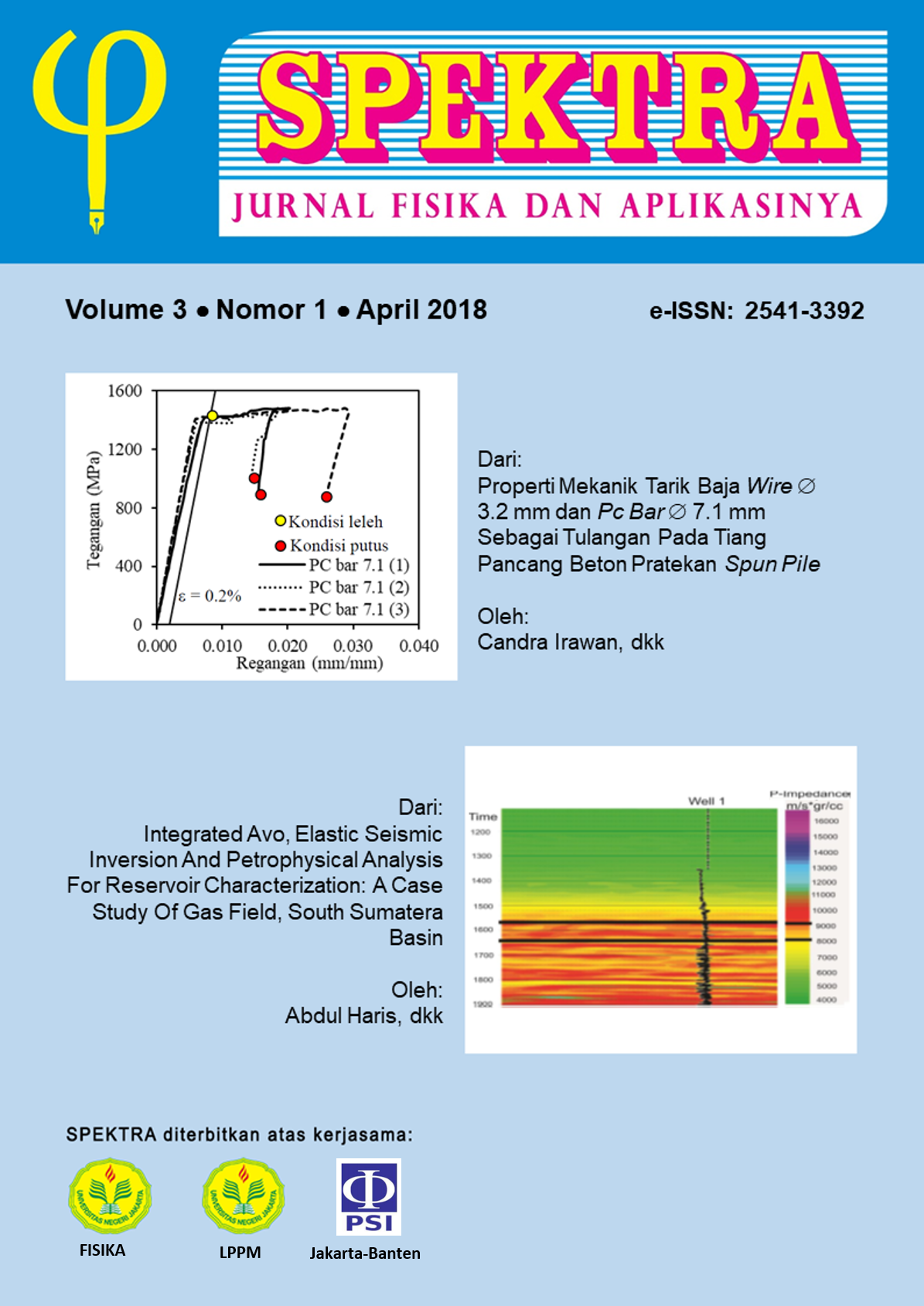PEMBUATAN GRAFT TULANG DENGAN PROSES EKSTRAKSI SENYAWA HIDROKSIAPATIT DARI TULANG KORTEKS SAPI
DOI:
https://doi.org/10.21009/SPEKTRA.031.05Keywords:
Hydroxyapatite, cow bone cortex, Natrium Hydroxide, extraction, bone graftAbstract
Abstrak
Pembuatan senyawa hidrosiapatit dari tulang kortek paha sapi dengan proses ekstraksi telah dilakukan. Penelitian ini bertujuan untuk menghilangkan senyawa organik pada tulang sehingga dapat digunakan sebagai bahan baku graft tulang. Metode yang digunakan adalah metode kimia dengan merendam tulang di dalam larutan Natrium Hidroksida (NaOH). Pengaruh variasi konsentrasi dan waktu perendaman NaOH terhadap proses ekstraksi tulang dikaji. Variasi konsentrasi larutan yang digunakan adalah 1M, 2M dan 3M dengan waktu perendaman 30 menit, 60 menit, dan 90 menit di dalam autoklaf bertekanan 1,5 atm dan temperatur 121°C. Hasil rendaman dianalisa dengan FTIR dan menunjukan adanya puncak gugus fungsi zat anorganik P-O, CO3 2- , dan O-H menyerupai kandungan tulang manusia. Sampel yang direndam pada larutan NaOH pada konsentrasi 1M dan 2M dengan waktu perendaman 30 menit masih ditemukan gugus fungsi C-H, yang mengindikasikan bahwa serbuk hidroksiapatit masih mengandung material organik sehingga beresiko pada reaksi penolakan oleh tubuh manusia saat diimplan. Namun demikian, serbuk hidroksiapatit yang dihasilkan dengan perendaman pada konsentrasi 3M dengan waktu 30 menit sudah tidak mengandung unsur organik, sehingga dapat digunakan sebagai bahan baku graft tulang.
Kata-kata kunci: hidroksiapatit, kortek tulang sapi, Natrium Hidroksida, ekstraksi, graft tulang.
Abstract
The extraction of hydroxyapatite compounds from thigh bones cortex has been done. This research was aimed to remove the organic substances in the bones, so that it can be maintained as the raw material of a bone graft. The research employed a chemical method, the bone was soaked in the Natrium Hydroxide (NaOH) solution. The effect of various concentration and duration of bone's immersion in NaOH were also studied. The solution's various concentrations were 1M, 2M and 3M, therefore the various of immersion duration were 30 minutes, 60 minutes and 90 minutes in a 1.5 atm autoclave at a temperature of 121o C. The immersion results were studied throughout FTIR. The results showed that there were some peaks of the inorganic P-O, CO3 2- and O-H substance function, correspond to a human bone characteristic. Samples which were immersed in the 1M and 2M of NaOH solution with duration of 30 minutes have yet a C-H functional group. It indicated that the hydroxyapatite powders have yet organic substances, so there is still a risk of rejection by the human body when it is implanted. However, the sample which was immersed in 3M of NaOH solution with duration of 30 minutes has no any organic substances, it can be used as the raw material of a bone graft.
Keywords: Hydroxyapatite, cow bone cortex, Natrium Hydroxide, extraction, bone graft
References
[2] M. Boutinguiza, J. R, “Biological hydroxyapatite obtained from fish bonesâ€. Elsevier Material Science and Engineering, 2011.
[3] Hardja, W. K, “Karakterisasi Sifat Fisika dan Kimia Tulang Korteks Sapi (Bos sondaicus) Hasil Pemanasan yang akan Digunakan untuk Transplantasi Graft Tulangâ€, Jakarta, Indoneisa: Skripsi, Universitas Pancasila, 2012.
[4] Sugandi, Siregar, H. A., & Darsini, E, “Pemanfaatan Cangkang Kerang Hijau (Pernia viridis L.) sebagai Bone Subtitute Berporogen Selulosa Nata De Cocoâ€, Bogor, Indonesia: Institut Pertanian Bogor, 2014.
[5] Purwasasmita, B. S & Gultom, R. S, “Sintesis dan Karakterisasi Serbuk Hidroksiapatit Skala Sub-Mikron Menggunakan Metode Presipitasiâ€. Jurnal Bionatura, 2008.
[6] Sobczak, A, Kowalski, Z & Wzorek, Z. “Preparation of Hydroxyapatite from Animal Bonesâ€. Acta of Bioengineering and Biomechanics, 2009.
[8] Baco, S. Bambang, L., Joseph, N., Yassin, M. F., & Basri, N. F. “Structural and Composition of Natural Hydroxyapatite (HA) at Different Sintering Temperaturesâ€. Malaysian Journal of Fundamental and Applied Sciences. Malaysia, 2013.
[9] Barakat, N. A., Khil, M. S., Omran, A., Sheikh, F. A., & Kim, Y. H. “Extraction of Pure Natural Hydroxyapatite from the Bovine Bones Bio Waste by Three Different Methodsâ€. Journal of Materials Processing Technology. 2008.
[10] P., A. R. “Preparasi Hidroksiapatit dari Tulang Sapi dengan Metode Kombinasi Ultrasonik dan Spray Dryingâ€. Skripsi. Depok, Indonesia: Universitas Indonesia, 2012.
[11] Hilmi, R., & M, H. “Synthesis of HYdroxyapatite from Local Bovine Bones for Biomedical Application,†International Conference on Instrumentation, Communication, Information Technology and Biomedical Engineering, 2011.
[12] Sokowati, W. “Isolasi dan Karakterisasi Senyawa Hidroksiapatit dari Tulang Korteks Sapi (Bos taurus),â€. Jakarta, Indonesia: Skripsi. Universitas Pancasila, 2014.
Downloads
Published
How to Cite
Issue
Section
License
SPEKTRA: Jurnal Fisika dan Aplikasinya allow the author(s) to hold the copyright without restrictions and allow the author(s) to retain publishing rights without restrictions. SPEKTRA: Jurnal Fisika dan Aplikasinya CC-BY or an equivalent license as the optimal license for the publication, distribution, use, and reuse of scholarly work. In developing strategy and setting priorities, SPEKTRA: Jurnal Fisika dan Aplikasinya recognize that free access is better than priced access, libre access is better than free access, and libre under CC-BY or the equivalent is better than libre under more restrictive open licenses. We should achieve what we can when we can. We should not delay achieving free in order to achieve libre, and we should not stop with free when we can achieve libre.
 SPEKTRA: Jurnal Fisika dan Aplikasinya is licensed under a Creative Commons Attribution 4.0 International License.
SPEKTRA: Jurnal Fisika dan Aplikasinya is licensed under a Creative Commons Attribution 4.0 International License.
You are free to:
Share - copy and redistribute the material in any medium or format
Adapt - remix, transform, and build upon the material for any purpose, even commercially.
The licensor cannot revoke these freedoms as long as you follow the license terms.

 E-ISSN 2541-3392
E-ISSN 2541-3392  Focus & Scope
Focus & Scope  Editorial Team
Editorial Team  Reviewer Team
Reviewer Team  Author Guidelines
Author Guidelines  Article Template
Article Template  Author Fee
Author Fee  Publication Ethics
Publication Ethics  Plagiarism Policy
Plagiarism Policy  Open Access Policy
Open Access Policy  Peer Review Process
Peer Review Process  Retraction & Correction
Retraction & Correction  Licensing & Copyright
Licensing & Copyright  Archiving & Repository
Archiving & Repository  Contact
Contact  Mendeley
Mendeley 

